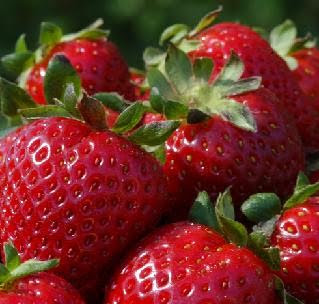Rubus Berry Plants
Strawberry
Rubus Berry Plants
Strawberry
Fragaria is a Genus of Flowering plants in the rose Family, Rosaceae, commonly known as Strawberry for their edible Fruits. Originally straw was used as a mulch in cultivating the Plants, which may have led to its name. There are more than 20 described Species and many hybrids and cultivars. The most common Strawberries grown commercially are cultivars of the garden strawberry, a hybrid known as Fragaria × ananassa. Strawberries have a taste that varies by cultivar, and ranges from quite sweet to rather tart. Strawberries are an important commercial fruit crop, widely grown in all temperate regions of the world.
As a rough rule (with exceptions), Strawberry Species with more chromosomes tend to be more robust and produce larger plants with larger berries (Darrow).
Strawberries are not true Berries, contrary to the nomenclature. They are actually classified as an Achene indehiscent fruit.
* Fragaria iinumae Makino (East Russia, Japan)
* Fragaria nilgerrensis Schlecht. ex J.Gay (South and Southeast Asia)
* Fragaria nipponica Makino (Japan)
* Fragaria nubicola Lindl. ex Lacaita (Himalayas)
* Fragaria vesca Coville - Woodland Strawberry (Northern Hemisphere)
* Fragaria viridis Duchesne (Europe, Central Asia)
* Fragaria yezoensis H.Hara (Northeast Asia)
* Fragaria orientalis Lozinsk. - (eastern Asia, eastern Siberia)
* Fragaria chiloensis (L.) Mill. - Beach Strawberry (Western Americas)
* Fragaria virginiana Mill. - Virginia Strawberry (North America)
* Fragaria ×vescana
Classification
There are more than 20 different Fragaria Species worldwide. Key to the classification of Strawberry Species is recognizing that they vary in the number of chromosomes. There are seven basic types of chromosomes that they all have in common. However, they exhibit different polyploidy. Some Species are diploid, having two sets of the seven chromosomes (14 chromosomes total). Others are tetraploid (four sets, 28 chromosomes total), hexaploid (six sets, 42 chromosomes total), octoploid (eight sets, 56 chromosomes total), or decaploid (ten sets, 70 chromosomes total).As a rough rule (with exceptions), Strawberry Species with more chromosomes tend to be more robust and produce larger plants with larger berries (Darrow).
Strawberries are not true Berries, contrary to the nomenclature. They are actually classified as an Achene indehiscent fruit.
Diploid species
* Fragaria daltoniana J.Gay (Himalayas)* Fragaria iinumae Makino (East Russia, Japan)
* Fragaria nilgerrensis Schlecht. ex J.Gay (South and Southeast Asia)
* Fragaria nipponica Makino (Japan)
* Fragaria nubicola Lindl. ex Lacaita (Himalayas)
* Fragaria vesca Coville - Woodland Strawberry (Northern Hemisphere)
* Fragaria viridis Duchesne (Europe, Central Asia)
* Fragaria yezoensis H.Hara (Northeast Asia)
Tetraploid species
* Fragaria moupinensis Cardot (China)* Fragaria orientalis Lozinsk. - (eastern Asia, eastern Siberia)
Hexaploid species
* Fragaria moschata Duchesne - Musk Strawberry (Europe)Octoploid species and hybrids
* Fragaria × ananassa Duchesne - Garden Strawberry* Fragaria chiloensis (L.) Mill. - Beach Strawberry (Western Americas)
- Fragaria chiloensis subsp. chiloensis forma chiloensis
- Fragaria chiloensis subsp. chiloensis forma patagonica (Argentina, Chile)
- Fragaria chiloensis subsp. lucida (E. Vilm. ex Gay) Staudt (coast of British Columbia, Washington, Oregon, California)
- Fragaria chiloensis subsp. pacifica Staudt (coast of Alaska, British Columbia, Washington, Oregon, California)
- Fragaria chiloensis subsp. sandwicensis (Decne.) Staudt - Ohelo papa (Hawaii)
* Fragaria virginiana Mill. - Virginia Strawberry (North America)
Decaploid species and hybrids
* Fragaria × Potentilla hybrids* Fragaria ×vescana
Related : Strawberry From Wikipedia, the free encyclopedia, Rubus Berry Plants











 2:38 AM
2:38 AM
 Goohara
Goohara
















0 ความคิดเห็น:
Post a Comment